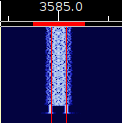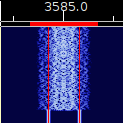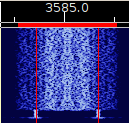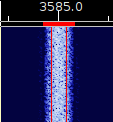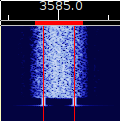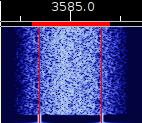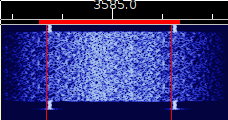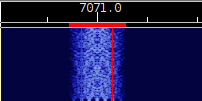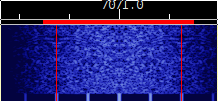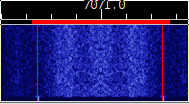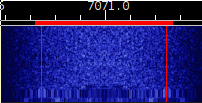tick marks shown at 100 Hz intervals
General Description
Narrow band modes such as PSK31 are low symbol rate, single carrier
differential Binary PSK (called 2-PSK or BPSK) or Quadrature
PSK (4-PSK or QPSK). With digital phase modulation the phase changes
abruptly, and without additional measures wide sidebands
would be created. To prevent this, all these modes also include 100%
raised-cosine amplitude modulation (ASK) at the symbol rate, which
reduces the power to zero at the phase change.
Because of this amplitude modulation, the signal bandwidth is
relatively narrow. Synchronization at the receiver is
straightforward because it can be recovered from the amplitude
information. Differential PSK is used to provide continuous
phase changes when idle (to maintain sync), and by allowing the
receiver to measure phase difference from symbol to symbol,
to reduce the effects of ionospheric Doppler phase changes which
modulate the signal. The slower modes are more
affected by Doppler, and the QPSK modes are particularly affected.
With no interleaver and limited coding length, the QPSK mode Forward
Error Correction coding gain is limited, and under burst noise
conditions (HF) the performance is usually worse than the BPSK option
at the same baud rate. In general the narrow-band BPSK modes work well
on a quiet single-hop path, but give poor performance in most other
conditions.
To counter this lack of robustness under adverse conditions, the
PSKR ("R" for "robust"), series of modes has been developed. Using a
similar design as the MFSK modes with a convolutional encoder and an
interleaver these modes provide a much more robust link at the expense
of the data speed which is divided by half when compared to the
standard BPSK mode. Soft bits decoding was also added to maximize the
probabilities of decoding the right sequence.
With these modes, a very linear transmitter is required. Over-driven
operation results in excessive
bandwidth, poorer reception and difficult tuning. However, the
sensitivity is such that very little power
is usually required.
Protocol
The BPSK modes are unconnected, manually controlled message
asynchronous simplex chat modes, used
without Forward Error Correction. The default calling mode is
BPSK31. PSK63F is a mode ideally suited for keyboard to keyboard
chat. The PSK-R modes are designed for use with data transfer
applications
such as pskmail, flarq or other automated-repeat-request applications.
Coding and Character Set
A binary varicode with ASCII-256 user interface is used. Lower case
characters are sent faster. Modulation is bit-wise symbol synchronous,
differential.
The QPSK modes use binary convolution to generate two dibits per
varicode bit at the same symbol rate. Rate R=1/2, Constraint
length
K=5. No interleaver is used. Two-bit quadrature modulation is based on
a differential code table.
The PSKR modes use binary convolution to generate two bits per
varicode bit at the same symbol rate. These modes us Rate R=1/2,
Constraint length K=7 with diagonal interleavers, variable in size to
keep the timing between redundant information constant. The
number of interleavers for each baud rate is 40, 80 and 160 for
PSK125R, PSK250R and PSK500R respectively. PSKR modes use the
MFSK varicode which provides a small increase in average speed of about
13%.
The PSK63FEC (also PSK63F in short) is identical to the PSKR modes but
for the absence of an interleaver.
Operating Parameters
| Mode |
Symbol Rate |
Typing Speed1 |
Duty Cycle2 |
Bandwidth3 |
ITU Designation4 |
| BPSK315 |
31.25 baud |
50 wpm |
~ 80% |
62.5 Hz |
63H0G1B |
| BPSK63 |
62.5 baud |
100 wpm |
~ 80% |
125 Hz |
125HG1B |
| BPSK125 |
125 baud |
200 wpm |
~ 80% |
250 Hz |
250HG1B |
| BPSK250 |
250 baud |
400 wpm |
~ 80% |
500 Hz |
500HG1B |
BPSK500
|
500 baud
|
800 wpm
|
~ 80%
|
1000 Hz
|
1000HG1B
|
| QPSK31 |
31.25 baud |
50 wpm |
~ 80% |
62.5 Hz |
63H0G1B |
| QPSK63 |
62.5 baud |
100 wpm |
~ 80% |
125 Hz |
125HG1B |
| QPSK125 |
125 baud |
200 wpm |
~ 80% |
250 Hz |
250HG1B |
| QPSK250 |
250 baud |
400 wpm |
~ 80% |
500 Hz |
500HG1B |
QPSK500
|
500 baud
|
800 wpm
|
~ 80%
|
1000 Hz
|
1000HG1B
|
PSK63FEC
|
62.5 baud
|
55 wpm
|
~ 80%
|
125 Hz
|
125HG1B
|
PSK125R
|
125 baud
|
110 wpm
|
~ 80%
|
250 Hz
|
250HG1B
|
PSK250R
|
250 baud
|
220 wpm
|
~ 80%
|
500 Hz
|
500HG1B
|
PSK500R
|
500 baud
|
440 wpm
|
~ 80%
|
1000 Hz
|
1000HG1B
|
Notes:
1. WPM is based on an average 5 characters per word, plus word
space. Values based on sending
100 "paris " words.
2. Transmitter average power output relative to a constant carrier of
the same PEP value.
3. This is the "Necessary Bandwidth" as defined by the ITU.
4. A summary of the ITU Designation system can be found at
http://en.wikipedia.org/wiki/Types_of_radio_emissions
